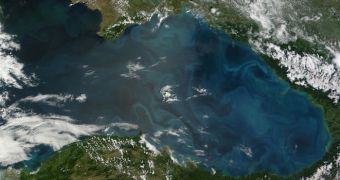In this natural-color image collected on May 18, the Black Sea reveals its massive phytoplankton bloom. The photo was snapped using the Moderate Resolution Imaging Spectroradiometer (MODIS) instrument aboard the NASA Terra satellites.
MODIS was focused on the eastern half of the sea, and reveals impressive amounts of phytoplankton, in milky, light blue and turquoise. These organisms are the first link in marine and oceanic food chains.
Phytoplankton is made up of protists, bacteria and algae that use nutrients delivered by rivers to conduct photosynthesis. The amount of runoff present in the water determines their numbers. The Black Sea primarily receives nutrients from the Danube, the Dnieper, the Dniester, and the Don rivers.
An interesting aspect of this particular sea is that its water column has a layered structure, which further promotes phytoplankton growth. The Black Sea is connected to the Aegean and Mediterranean seas through the Bosporus and Dardanelles straits.

 14 DAY TRIAL //
14 DAY TRIAL //